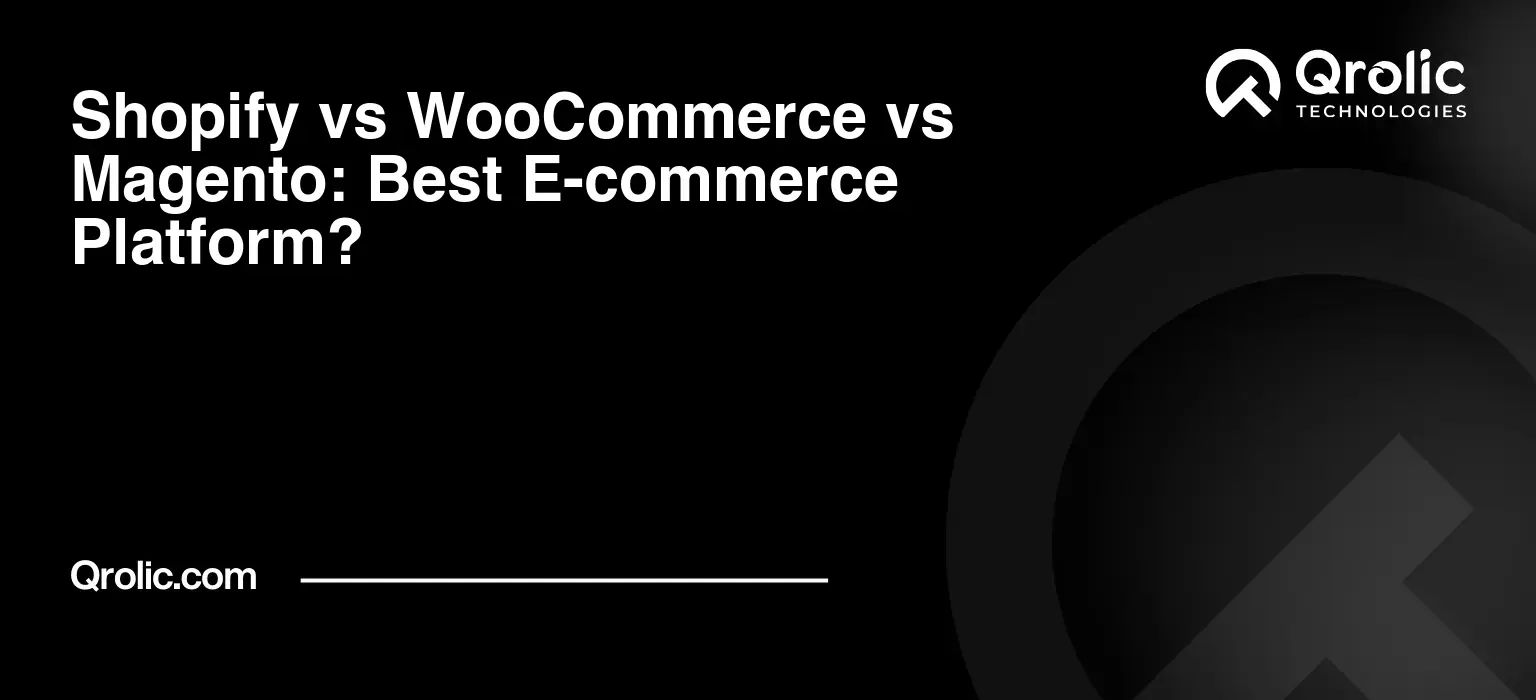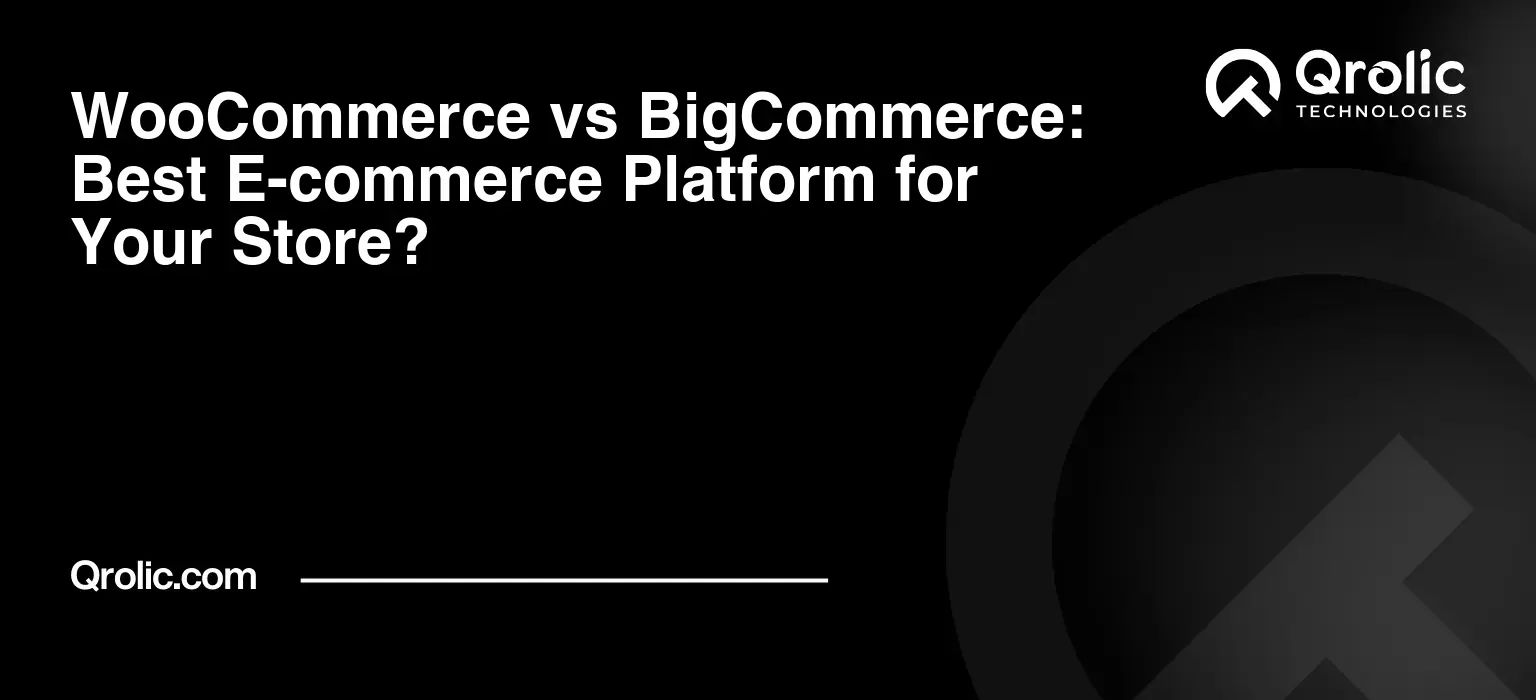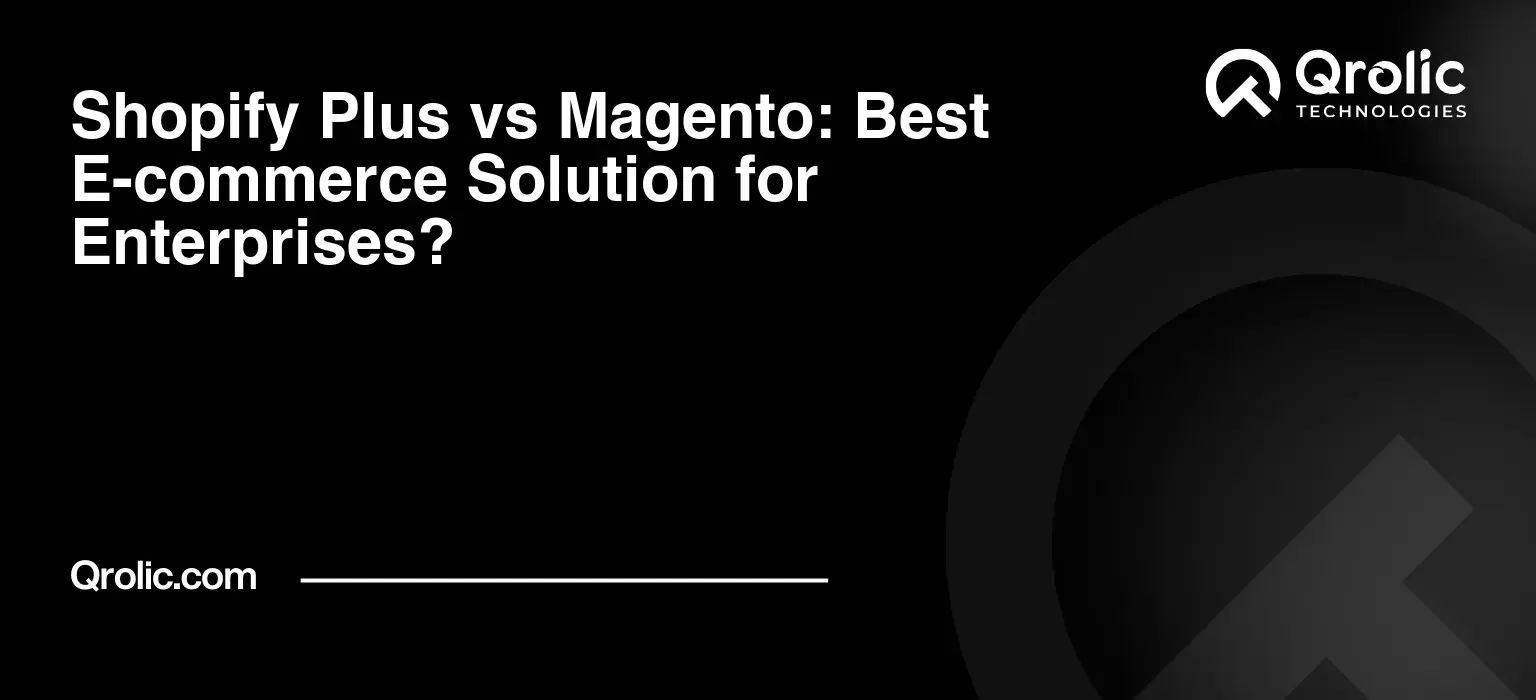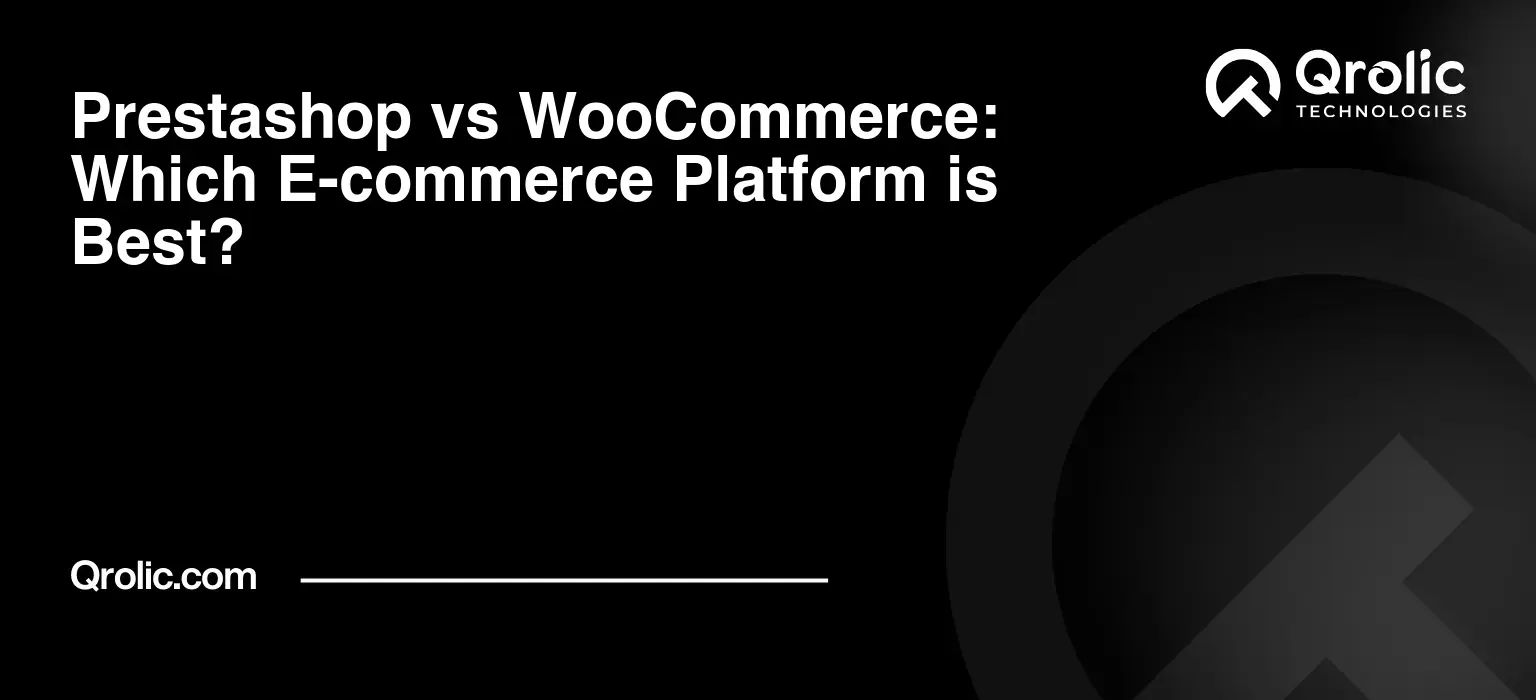Quick Summary:
- Shopify is easy, all-in-one for beginners.
- WooCommerce offers flexibility with WordPress.
- Magento is powerful for large, complex stores.
- Choose based on your skills, budget, and needs.
Table of Contents
- Shopify vs WooCommerce vs Magento: Best E-commerce Platform?
- Understanding the Landscape: Shopify, WooCommerce, and Magento
- Key Differences: A Head-to-Head Comparison
- 1. Ease of Use: The User Experience Factor
- 2. Pricing: Understanding the Cost Breakdown
- 3. Features and Functionality: Meeting Your Business Needs
- 4. Customization and Flexibility: Shaping Your Brand Identity
- 5. Scalability: Growing with Your Business
- 6. SEO (Search Engine Optimization): Getting Found Online
- 7. Security: Protecting Your Customers’ Data
- 8. Support: Getting Help When You Need It
- 9. Payment Gateways: Seamless Transactions
- 10. Mobile Friendliness: Reaching Customers on the Go
- Choosing the Right Platform: A Step-by-Step Guide
- Real-World Examples: Who Uses What?
- Key Takeaways: Summarizing the Choices
- The Future of E-commerce Platforms
- Need Expert Help? Consider Qrolic Technologies
- Conclusion: Empowering Your E-commerce Journey
Shopify vs WooCommerce vs Magento: Best E-commerce Platform?
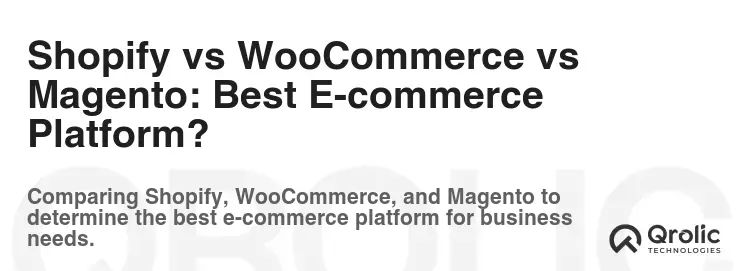
Choosing the right e-commerce platform is like picking the perfect foundation for your dream house. Get it wrong, and you’ll be dealing with cracks and leaks for years to come. Get it right, and you’ll have a solid base upon which to build a thriving online business. That’s why understanding the nuances of Shopify, WooCommerce, and Magento – three of the leading e-commerce contenders – is absolutely crucial.
This article will dive deep, exploring every nook and cranny of these platforms to help you make an informed decision that aligns perfectly with your business needs and aspirations. We’ll examine their strengths, weaknesses, pricing structures, ease of use, scalability, and much more. So, buckle up and get ready to embark on a comprehensive journey to find the best e-commerce platform for your online store.
Understanding the Landscape: Shopify, WooCommerce, and Magento
Before we dive into the specifics, let’s establish a clear understanding of what each platform offers:
- Shopify: Think of Shopify as the all-in-one solution. It’s a fully hosted, subscription-based platform that handles everything from hosting and security to payment processing and updates. You don’t need to worry about technical complexities; Shopify takes care of it all. This allows you to focus solely on building your brand and selling your products. It’s the “plug-and-play” option for entrepreneurs who want a streamlined experience.
- WooCommerce: WooCommerce is a plugin that transforms your wordpress website into a fully functional e-commerce store. This means you need an existing WordPress site (or create one), and you’re responsible for hosting, security, and updates. However, this also grants you unparalleled flexibility and control over your website. Think of it as building your dream house from scratch, brick by brick.
- Magento: Magento is an open-source platform known for its robust features and immense scalability. It’s a powerhouse designed for large, complex businesses with high sales volumes and intricate product catalogs. While Magento offers unparalleled customization options, it requires significant technical expertise to set up and manage. It’s like building a skyscraper – incredibly powerful, but requires a team of skilled architects and engineers.
Key Differences: A Head-to-Head Comparison
Now, let’s break down the key differences across various aspects of each platform.
1. Ease of Use: The User Experience Factor
- Shopify: Shopify shines in its intuitive interface and user-friendly design. Setting up a store is a breeze, even for beginners. The drag-and-drop functionality makes customization simple, and the comprehensive dashboard provides a clear overview of your store’s performance. Think of it as effortlessly navigating a well-designed app.
- WooCommerce: While WooCommerce offers more flexibility, it also comes with a steeper learning curve. You’ll need to be comfortable with WordPress and understand how to install and configure plugins. While there are plenty of tutorials and resources available, it requires more technical effort than Shopify. It’s like learning a new software program – initially challenging, but rewarding once mastered.
- Magento: Magento is notoriously complex. It’s designed for developers and experienced users. Setting up and managing a Magento store requires a deep understanding of coding and server management. If you’re not technically inclined, you’ll likely need to hire a developer. It’s like piloting a spaceship – you need extensive training and expertise.
Winner: Shopify for its unmatched ease of use and beginner-friendliness.
2. Pricing: Understanding the Cost Breakdown
- Shopify: Shopify operates on a subscription-based model, with different plans offering varying features and transaction fees. The Basic Shopify plan starts at around $29 per month, the Shopify plan at around $79 per month, and the Advanced Shopify plan at around $299 per month. Plus, there are transaction fees if you don’t use Shopify Payments. Consider the ongoing cost of the subscription and transaction fees when factoring in your business’s financial feasibility.
- WooCommerce: WooCommerce itself is free, but that’s just the tip of the iceberg. You’ll need to pay for hosting, a domain name, security certificates (SSL), and potentially premium themes and plugins. Hosting can range from a few dollars to hundreds of dollars per month, depending on your needs. While WooCommerce can be cheaper upfront, the ongoing costs can add up.
- Magento: Magento Open Source is also free to download and use. However, like WooCommerce, you’ll need to pay for hosting, security, and potentially developer fees. Magento Commerce, the enterprise version, comes with a hefty price tag, often running into the tens of thousands of dollars per year. The total cost of ownership for Magento can be significant.
Winner: WooCommerce, depending on your technical skills and ability to manage the hosting and maintenance yourself. For businesses needing enterprise-level support and features, Magento Commerce, despite the high price, offers unparalleled features and scalability.
3. Features and Functionality: Meeting Your Business Needs
- Shopify: Shopify offers a wide range of features, including a built-in payment gateway (Shopify Payments), abandoned cart recovery, marketing tools, and integrations with various apps and services. It has everything most small to medium-sized businesses need to get started.
- WooCommerce: WooCommerce is highly customizable and extensible. With thousands of plugins available, you can add almost any feature you can imagine, from advanced product filtering to membership management. The possibilities are virtually endless.
- Magento: Magento is renowned for its robust features, including advanced SEO capabilities, multi-store management, customer segmentation, and loyalty programs. It’s designed for businesses with complex requirements and high sales volumes.
Winner: Magento for its extensive feature set and scalability, especially for large enterprises. WooCommerce offers the most flexibility for customization through plugins.
4. Customization and Flexibility: Shaping Your Brand Identity
- Shopify: Shopify offers a decent level of customization through its themes and app store. However, you’re limited to the options provided by Shopify. While you can edit the theme code, it requires knowledge of Liquid (Shopify’s templating language).
- WooCommerce: WooCommerce provides unparalleled flexibility and customization. You can modify virtually every aspect of your store, from the design to the functionality. You have complete control over your website.
- Magento: Magento offers a high degree of customization, but it requires significant technical expertise. You can customize the code to create a truly unique and bespoke e-commerce experience.
Winner: WooCommerce for its unparalleled flexibility and control.
5. Scalability: Growing with Your Business
- Shopify: Shopify is designed to scale with your business. It can handle increasing traffic and sales without requiring you to worry about server management.
- WooCommerce: WooCommerce’s scalability depends on your hosting provider and the resources allocated to your website. As your business grows, you may need to upgrade your hosting plan to handle the increased traffic.
- Magento: Magento is built for scalability. It can handle massive product catalogs and high sales volumes. However, scaling a Magento store requires careful planning and optimization.
Winner: Magento for its robust scalability and ability to handle complex product catalogs and high traffic volumes.
6. SEO (Search Engine Optimization): Getting Found Online
- Shopify: Shopify offers built-in SEO features, such as customizable title tags and meta descriptions. It also integrates with various SEO apps to further optimize your store for search engines.
- WooCommerce: WooCommerce, combined with WordPress, is an SEO powerhouse. WordPress is known for its SEO-friendly structure, and WooCommerce plugins like Yoast SEO provide advanced SEO capabilities.
- Magento: Magento offers advanced SEO features, including URL rewriting, XML sitemaps, and canonical tags. It’s designed to help you rank high in search engine results.
Winner: WooCommerce, due to the inherent SEO advantages of the WordPress platform and the availability of powerful SEO plugins. Magento is also a strong contender, particularly for larger businesses with more complex SEO needs.
7. Security: Protecting Your Customers’ Data
- Shopify: Shopify handles security for you, including SSL certificates and PCI compliance. You can rest assured that your customers’ data is safe and secure.
- WooCommerce: You’re responsible for securing your WooCommerce Store. This includes installing an SSL certificate, choosing a secure hosting provider, and keeping your WordPress and WooCommerce plugins up to date.
- Magento: You’re also responsible for securing your Magento store. Magento offers security patches and best practices, but it’s up to you to implement them.
Winner: Shopify for its built-in security features and hassle-free management.
8. Support: Getting Help When You Need It
- Shopify: Shopify provides 24/7 support via phone, email, and live chat. They also have a comprehensive help center with articles and tutorials.
- WooCommerce: WooCommerce offers limited direct support. However, you can find extensive documentation and community forums. You can also hire a WordPress Developer for more personalized support.
- Magento: Magento offers support through its network of partners and developers. You can also find community forums and documentation.
Winner: Shopify for its comprehensive and readily available support.
9. Payment Gateways: Seamless Transactions
- Shopify: Shopify offers its own payment gateway (Shopify Payments) and integrates with other popular payment gateways like PayPal, Stripe, and Amazon Pay.
- WooCommerce: WooCommerce integrates with a wide range of payment gateways, giving you plenty of options to choose from.
- Magento: Magento also integrates with numerous payment gateways, offering flexibility in accepting payments.
Winner: Tie. All three platforms offer a wide range of payment gateway options.
10. Mobile Friendliness: Reaching Customers on the Go
- Shopify: Shopify themes are inherently mobile-friendly, ensuring a seamless shopping experience on all devices.
- WooCommerce: WooCommerce themes can be mobile-friendly, but it’s important to choose a theme that is specifically designed for mobile devices.
- Magento: Magento themes can also be mobile-friendly, but careful theme selection and optimization are crucial.
Winner: Shopify, as all its themes are optimized for mobile by default.
Choosing the Right Platform: A Step-by-Step Guide
Choosing the best e-commerce platform isn’t about picking the “best” overall option; it’s about selecting the platform that best aligns with your specific needs, budget, and technical skills. Here’s a step-by-step guide to help you make the right decision:
- Define Your Business Needs: Start by clearly defining your business requirements. Consider the following:
- Product Catalog Size: How many products do you plan to sell?
- Sales Volume: What are your expected sales volumes?
- Technical Skills: How comfortable are you with coding and server management?
- Budget: What’s your budget for setting up and maintaining your store?
- Desired Features: What specific features do you need (e.g., subscriptions, memberships, advanced SEO)?
- Scalability Goals: How much do you expect your business to grow in the next few years?
- Evaluate Your Options: Based on your business needs, evaluate Shopify, WooCommerce, and Magento. Consider the following factors:
- Ease of Use: Is the platform easy to set up and manage?
- Pricing: Does the pricing structure fit your budget?
- Features: Does the platform offer the features you need?
- Customization: Does the platform allow you to customize your store to reflect your brand identity?
- Scalability: Can the platform handle your expected growth?
- Security: Is the platform secure?
- Support: Is there adequate support available?
- Try Before You Buy: Many platforms offer free trials or demo versions. Take advantage of these opportunities to test the platform and see if it’s a good fit for your needs.
- Read Reviews and Case Studies: Read reviews and case studies from other users to get a better understanding of the platform’s strengths and weaknesses.
- Consult with Experts: If you’re unsure which platform is right for you, consult with e-commerce experts or developers who can provide personalized advice.
- Make a Decision and Get Started: Once you’ve carefully considered all the factors, make a decision and start building your online store!
Real-World Examples: Who Uses What?
To further illustrate the differences between the platforms, let’s look at some real-world examples:
- Shopify:
- Allbirds: A popular shoe brand known for its sustainable materials. They use Shopify for its ease of use and streamlined design.
- Gymshark: A fitness apparel brand that started as a small online store and has grown into a global powerhouse. They use Shopify Plus, the enterprise version of Shopify, to handle their high sales volumes.
- WooCommerce:
- Blue Star Coffee Roasters: A specialty coffee roaster that uses WooCommerce to sell its coffee beans online. They appreciate the flexibility and customization options that WooCommerce offers.
- Porter & York: A butcher shop that sells high-quality meats online. They use WooCommerce to manage their complex product catalog and shipping requirements.
- Magento:
- Land Rover: The luxury car brand uses Magento Commerce to showcase its vehicles and accessories online. They require the robust features and scalability that Magento offers.
- Oliver Sweeney: A high-end shoe brand that uses Magento Commerce to manage its global e-commerce operations. They need the advanced SEO capabilities and multi-store management features that Magento provides.
Key Takeaways: Summarizing the Choices
- Choose Shopify If: You’re a beginner looking for an easy-to-use, all-in-one platform with excellent support. You value simplicity and don’t want to worry about technical complexities.
- Choose WooCommerce If: You’re comfortable with WordPress and want maximum flexibility and customization. You want to have complete control over your website and don’t mind managing hosting and security.
- Choose Magento If: You’re a large business with complex requirements and high sales volumes. You need advanced features, scalability, and are willing to invest in technical expertise.
The Future of E-commerce Platforms
The e-commerce landscape is constantly evolving. New technologies and trends are emerging all the time. Here are some key trends to watch out for:
- Headless Commerce: Decoupling the front-end (customer-facing) and back-end (platform) of your e-commerce store for greater flexibility and customization.
- AI and Machine Learning: Using AI to personalize the shopping experience, automate tasks, and improve marketing efforts.
- Mobile-First Design: optimizing your e-commerce store for mobile devices to cater to the growing number of mobile shoppers.
- Sustainability: Focusing on sustainable practices and eco-friendly products to appeal to environmentally conscious consumers.
- Augmented Reality (AR): Using AR to allow customers to visualize products in their own homes before making a purchase.
By staying informed about these trends and adapting your e-commerce strategy accordingly, you can ensure your online store remains competitive and successful.
Need Expert Help? Consider Qrolic Technologies
Navigating the complex world of e-commerce platforms can be overwhelming. If you need expert guidance and support, consider partnering with Qrolic Technologies.
Qrolic Technologies is a leading technology company specializing in e-commerce solutions. We offer a comprehensive range of services, including:
- E-commerce platform selection and implementation: We can help you choose the right platform for your business and seamlessly integrate it into your existing infrastructure.
- Custom website design and development: We can create a visually stunning and user-friendly e-commerce website that reflects your brand identity.
- SEO and digital marketing: We can help you optimize your website for search engines and drive traffic to your online store.
- Ongoing maintenance and support: We provide ongoing maintenance and support to ensure your e-commerce store runs smoothly and efficiently.
At Qrolic Technologies, we’re passionate about helping businesses succeed online. We combine our technical expertise with a deep understanding of the e-commerce landscape to deliver tailored solutions that drive results.
Contact us today to learn more about how we can help you build a thriving online business. https://qrolic.com/
Conclusion: Empowering Your E-commerce Journey
Choosing the right e-commerce platform is a critical decision that can significantly impact the success of your online business. By understanding the strengths and weaknesses of Shopify, WooCommerce, and Magento, and carefully considering your business needs, you can make an informed choice that sets you up for long-term growth and prosperity. Remember to leverage resources like free trials, expert consultations, and comprehensive documentation to solidify your decision. Ultimately, the best e-commerce platform is the one that empowers you to build a thriving online store and achieve your business goals. Good luck on your e-commerce journey!
